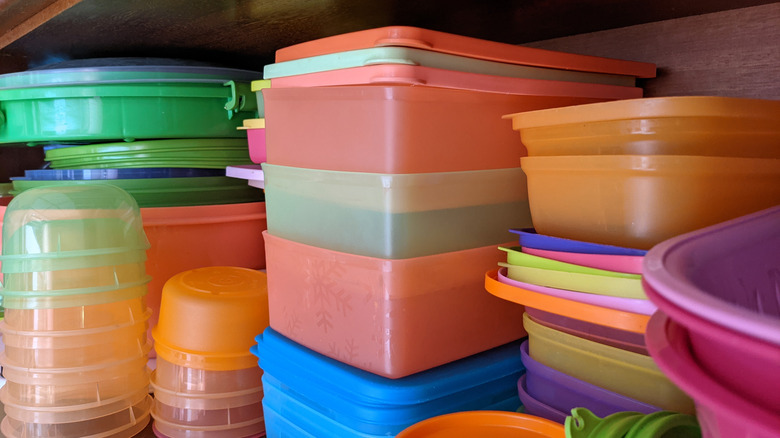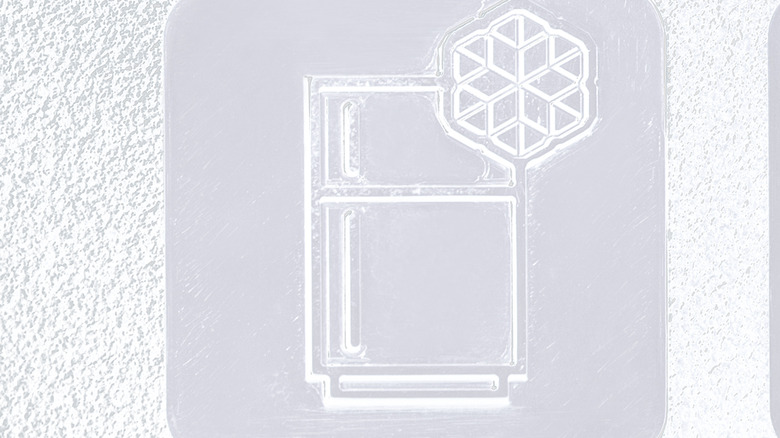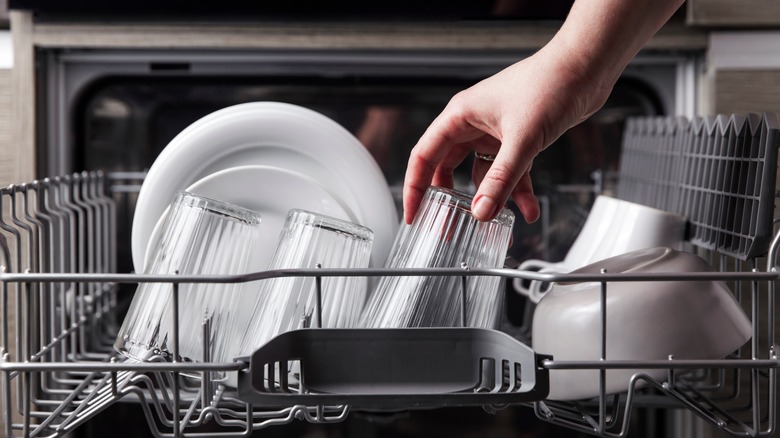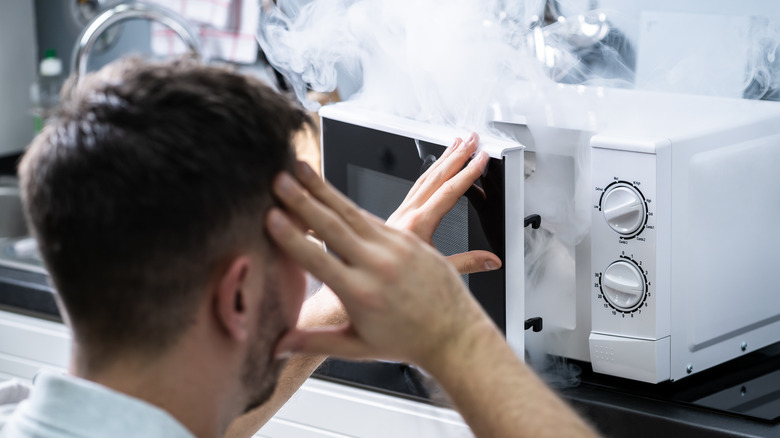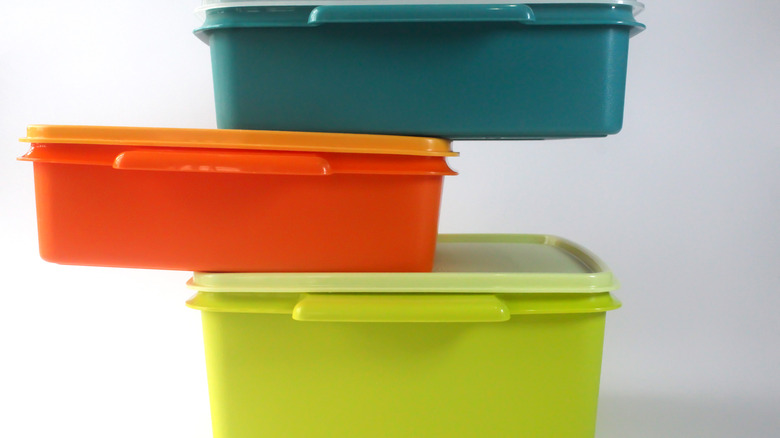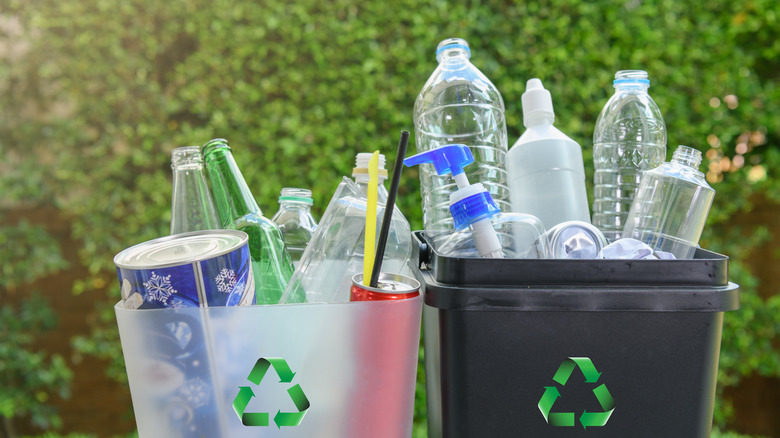Here's What The Different Tupperware Symbols Actually Mean
According to Tupperware, the now-iconic brand got its start when an innovative chemist, inspired by the seal on a paint can, sought out a way to create a similar container to cut down on food waste. Now, Tupperware is so popular that many use the term to simply refer to any plastic container used for storing leftovers, regardless of the actual brand — much like how "Band-Aid" now colloquially refers to all bandages, or how "Kleenex" colloquially refers to all tissues. You very likely have a stockpile of the stuff sitting in your kitchen right now, neatly stacked or otherwise.
But despite Tupperware's remarkable convenience and popularity, these plastic containers aren't as indestructible and all-purpose as you might assume. Sure, it seems easy and straightforward to throw your leftovers piping hot into your favorite well-worn Tupperware container, toss it into the freezer, and then back into the microwave before the dishwasher a week later — but should you be doing all this? Food can actually become toxic when reheated the wrong way and, sometimes, the wrong cleaning method can ruin your Tupperware. You might need to take a look at the symbols on the bottom of your plastic containers. They can tell you everything you should and shouldn't do with your most beloved plastic products.
The snowflake symbol
If you spot a snowflake symbol on the bottom of your plastic container — Tupperware or otherwise — it means the container is safe for freezer storage, according to the Plastics Industry Association. However, just because a container is suitable for freezer storage, that doesn't mean that there aren't still best practices for freezing foods in your Tupperware. Don't make a big mistake with your frozen food. For the best results, Tupperware has a few tips.
Rather than take your hot food directly from the pan into Tupperware and into the freezer, the brand recommends placing your hot food in a bowl and then placing that bowl in an ice bath, to cool the food as quickly as possible. Once the food is chilled, you can then place it in your plastic container for freezing. This is also a good time to remove any fat that may have accumulated at the top of your food during the cooling process. For easier thawing and reheating later, you can also think ahead and pre-portion your food so you only have to thaw what you want to eat at any given time. Tupperware also recommends undercooking your food just slightly before freezing, if you plan on cooking the food further after thawing.
The sudsy plates symbol
There are a few different symbols that may appear on the bottom of your Tupperware or other plastic containers that may indicate the container is safe to clean in the dishwasher versus by hand. Usually, though, despite variations, the dishwasher-safe symbol will depict a few dishes — plates, glasses, flatware, etcetera — surrounded by suds or water droplets or streams. Sometimes, you'll also see a small line of text below the symbol that will tell you if a container is only suitable for washing on your dishwasher's top rack (via the Plastics Industry Association).
However, as anyone who's washed a Tupperware container knows, getting your Tupperware truly sparkling clean is easier said than done. It's all too common to find the container has turned a distasteful orange or red hue after being filled with something like spaghetti or chili. To remove those unsightly stains, as well as remove odors from your Tupperware, the American Cleaning Institute recommends allowing the discolored containers to sit in the sun for several hours, before soaking them in a mixture of bleach and water — two teaspoons of bleach to every gallon of water — and then giving them another clean before use. You can also scrub your Tupperware with mixtures of baking soda and water — one teaspoon of baking soda to one cup of water.
The microwave symbol
If you're wondering whether or not it's really safe to pop that Tupperware container in the microwave, just look for the microwave symbol on the bottom of your container. As Tupperware tweeted, you'll see a box with three wavy lines inside it if the container is safe for microwave use.
Sometimes, the microwave symbol will differ, though, on plastic containers that are not officially Tupperware-branded. In these cases, the Plastics Industry Association notes, the symbol may show a more realistic rendering of a microwave, with buttons and a window; a dish of food with a series of wavy lines over it; just the wavy lines and the phrase "micro"; or just a series of wavy lines on their own.
However, even with that microwave-safe symbol, you still might want to think twice about microwaving your food in its plastic container. As Food Network explains, many plastic containers contain chemicals that may filter into your food when microwaving, especially if those plastic containers are on the older side and possibly scratched. So, next time you need to reheat your leftovers, just take that extra step to move them from the Tupperware to a plate and use this microwave trick that makes reheating leftovers easy — just in case.
The microwave symbol with a vertical line
Don't just assume that if you see a microwave symbol on the bottom of your plastic container that it's safe to use in the microwave. Look closely. If you see a box with three wavy lines and a larger, diagonal line set over it, keep the container out of the microwave, as Tupperware says that symbol means the container is not microwave-safe. You'll need to remove your food from the container and reheat it another way.
The U.S. Department of Agriculture recommends only reheating leftovers in the oven or on the stovetop or, in the microwave only with an appropriate container. Slow cookers aren't recommended for reheating leftovers, as the USDA says they won't reheat the leftovers quickly enough to keep food out of the "Danger Zone," where temperatures allow bacteria to grow. Regardless of your preferred method, make sure all your leftovers are reheated to at least 165 degrees. If you end up placing your leftovers on a microwave-safe dish and returning them to the microwave, the USDA further recommends covering the food and stirring and rotating it during the reheating process.
The fork and wine glass symbol
This is a symbol that you'll see on a variety of plastic products, beyond just food containers. The outline of a fork and wine glass, sometimes in a square or sometimes standing alone, indicates a plastic product is safe for food contact (via the Plastics Industry Association). But what exactly does "safe for food contact" mean?
According to Michigan State University Extension, a plastic container that's considered safe for food contact, or "food grade," is one that won't transfer chemicals onto your food that have been deemed unsafe for consumption. That doesn't, however, mean that food grade plastics aren't transferring any chemicals at all to your food or, later, into your body.
As The Guardian reported, a range of supposed safe chemicals have been found in common food-safe plastics, and some of these chemicals have even been linked to a variety of health issues. Furthermore, the Guardian article reported via a U.S. Food & Drug Administration spokesperson that the FDA doesn't actually double-check that all plastic containers are safe under all conditions. In fact, in many cases, it leaves labeling up to the manufacturer — yet another reason why you might just want to hand wash your plastic containers and forgo microwaving, regardless of what symbols you see on the bottom of your Tupperware.
Recycling symbols
You're probably familiar with recycling symbols since they're so prevalent in our daily lives. Most are just a triangle with a number inside. But even though you can recognize the symbol that indicates a product is fit for recycling, do you know what the recycling symbols on your plastic really mean or what the numbers indicate?
As Tupperware explains, in the plastic industry specifically, recycling symbols will include a number between 1 and 7. The number indicates the type of plastic used to create the product. Some Tupperware products feature a "7," which means the product was created using "polycarbonate, acrylic, liquid crystal polymers, and nylon" or a combination of plastic materials. However, Tupperware also said that some of its products do not show a recycling symbol at all, as Tupperware is intended to be reused, not recycled, and boasts a lifetime guarantee.
Broadly, though, the Plastic Soup Foundation notes that the plastic recycling symbols aren't commonly used by recycling centers and are most helpful as a way for consumers to decide what types of plastics they would prefer to use. Since symbols with the number 7 can be made from a combination of plastic materials, that's not very informative; however, plastic products displaying numbers 1, 2, 4, and 5 are considered safe for use around food, while those displaying numbers 3 and 6 are not (3 is most usually found on products like building materials, though 6 is sometimes found on disposable food packaging).
